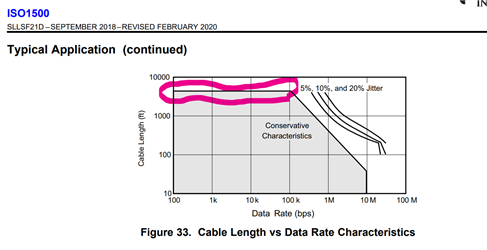Other Parts Discussed in Thread: ISO1500
Hello Expert,
I need some information to support our customer.
Could you please give me your answer about each questions?
1. What's the max. cable length on my marking of below figure 33?

2. Do you have a test result or simulation data about data rate vs cable length w/ ISO1500DBQEVM?
3. In condtion of max. 32node, cable length 1.2km and don't know cable type, what's the maximum supported data rate w/ ISO1500 in normally?
Their current configuration is non-isolated device + transformer.
In this condition, they implement and use up to 9600bps.
Finally, they want to get more data rate than 9600bps with isolated transceiver.
If you have any recommended part, you can suggest it.
Best regards,
Michael

